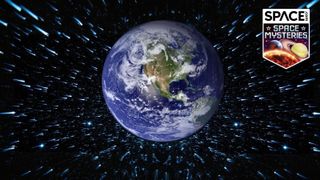
(Image credit: Robert Lea (created with Canva)/ Earth image NASA)
Earth is under constant bombardment by cosmic rays, showers of high-energy particles that blast our planet from all directions at near light speed.
While this might sound like the precursor to a sci-fi alien invasion, it is a real phenomenon that scientists have been aware of for over a century. Despite their dramatic description, cosmic rays are actually pretty ordinary — they pass through our planet so regularly that during an average night’s sleep, a person will have around a million cosmic rays traveling through their body, according to the University of Birmingham in the U.K.
Despite their ubiquity, cosmic rays still present scientific mysteries. While slow-energy cosmic rays that strike Earth are known to originate from the sun, others with higher energies stream into the solar system from deep space. The origins of these extrasolar cosmic rays are lesser known, with suspect sources including black holes and the supernova explosions that mark the deaths of massive stars.
Related: Space mysteries: Why are there no gas moons?
Cosmic rays “have been detected here on Earth for more than 100 years now. Yet, their origin remains largely unknown,” Julia Tjus, a professor of physics and astronomy at Ruhr University in Germany, told Space.com via email. “These tiny particles reach energies that go far beyond what we can reach here on Earth. We are trying to solve a riddle that is by now more than 100 years old and put together the pieces slowly but steadily.”
What are cosmic rays?
Cosmic rays are streams of high-energy particles that hit Earth’s atmosphere at near light speed. They were discovered in the 1900s, and the term “cosmic rays” was coined by physicist Robert Millikan in 1925.
Since then, scientists have determined that trillions of cosmic rays hit Earth every day, but the vast majority are blocked by the planet’s magnetosphere and atmosphere.
Over 90% of cosmic rays are hydrogen nuclei ( single protons), 9% are the atomic nuclei of helium, and 1% are the nuclei of heavy elements up to iron, according to the University of Chicago. These are called “hadronic particles” because they are composed of hadrons, like protons and neutrons, which are made up of fundamental particles called quarks.
“There are also electrons and positrons [the antiparticles of electrons] coming to us in cosmic rays but in smaller numbers than the hadronic particles. These are often called cosmic-ray electrons,” Tjus said. “Sometimes, people also include the neutral high-energy particles — photons and neutrinos — in the term cosmic rays, but in most definitions, these are kept separately.”
How do cosmic rays get so energetic?

The crux of the cosmic-ray mystery is how these particles can reach such incredible energies that cause them to accelerate to near light speed.
“We know the energies of cosmic rays quite well — the universe somehow accelerates particles up to 10²⁰ (1 followed by 20 zeroes) electronvolts (eV),” Tjus said. “In comparison, Earth-bound accelerators, like the Large Hadron Collider (LHC) at CERN, can only accelerate particles up to 10¹³ eV, many orders of magnitudes lower than what the universe can achieve. The mechanism of how to accelerate particles up to these extreme energies is not understood.”
One suggestion is that particles could be accelerated to such energies by a shock front that is created when a material traveling at an incredibly high velocity strikes a slower-moving medium, creating a sudden change in the latter. This would generate a turbulent magnetic field that could act as a natural and powerful cosmic particle accelerator.
One possible way of generating such conditions would be in a supernova, the explosion that occurs when a massive star dies. This blast would send the star’s outer layers hurtling at incredible speeds until this stellar material eventually struck the interstellar medium — slow-moving clouds of gas between stars — creating a glowing supernova remnant.
“Supernova remnants are reasonable candidates for cosmic rays that come from within the Milky Way. There is evidence that supernova remnants can accelerate particles up to around GeV energies [around 10⁹ to 10¹² eV],” Tjus said. “At the highest energies, around 10²⁰ eV, we know that these particles must come from other galaxies.”
She said one reasonable source of these higher-energy cosmic rays is active galactic nuclei (AGN), the centers of active galaxies that are powered by feeding supermassive black holes with masses millions or billions of times the mass of the sun.
AGN supermassive black holes are surrounded by matter that they gradually feed on, which they also churn around with their immense gravitational influence, causing them to glow brighter than the combined light of every star in the surrounding galaxy. Matter in these regions that isn’t fed to the central supermassive black hole can be channeled to the poles of the black hole, where it is blasted out as jets of matter at near light speed. When these jets strike surrounding interstellar material, this collision could also generate cosmic rays.
Another possible source of cosmic rays could be so-called starburst galaxies — meaning those that are undergoing an exceptionally high rate of star formation — that host gamma-ray bursts, Tjus said.
But if cosmic rays come from some of the most violent and conspicuous events in the universe, why do astronomers struggle to track these charged particles back to these sources?
A cosmic pinball machine
One reason it’s tough to find the sources of cosmic rays is because they are made of charged particles that are influenced by magnetic fields. When these particles encounter magnetic fields on their long journeys through space to reach us, they are deflected.
So by the time extragalactic cosmic rays reach Earth after traveling millions or billions of light-years, they have been deflected and redirected a multitude of times, ricocheting around the cosmos like a ball in a celestial pinball machine. This makes the reconstruction of their original path nearly impossible, but there may be an indirect way to do it.
“When cosmic rays interact with gas, these interactions lead to the production of photons and neutrinos. These are neutral particles that travel straight and can therefore indirectly reveal the origin of cosmic rays,” Tjus explained.
Currently, cosmic rays are studied across a wide range of energies, from 10⁹ eV to 10²⁰ eV, with scientists looking at everything from the cosmic rays’ compositions to their favored directions in the sky. Tjus thinks that with a combination of 3D modeling and precision measurements of neutrinos and photons associated with cosmic rays, progress can be made in understanding where cosmic rays come from and how they are launched with such incredible energies.
“The riddle of cosmic rays can only be solved by putting together different pieces of information from the different messengers that are observed,” Tjus said. “As of today, there is a large variety of observatories that provide different pieces of information.”‘
Join our Space Forums to keep talking space on the latest missions, night sky and more! And if you have a news tip, correction or comment, let us know at: community@space.com.
Note: This article have been indexed to our site. We do not claim legitimacy, ownership or copyright of any of the content above. To see the article at original source Click Here













